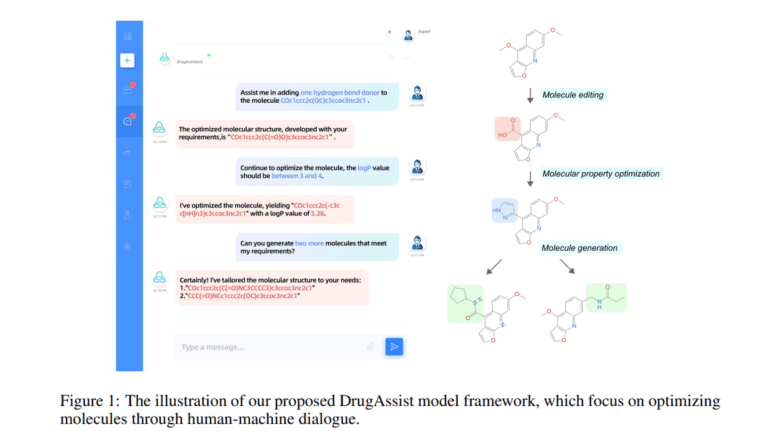TL;DR:
- DrugAssist, a novel LLM-based model, aims to enhance molecule optimization in drug discovery.
- Traditional methods focus on data patterns, neglecting expert feedback crucial in refining the process.
- MolOpt-Instructions, a comprehensive instruction-based dataset, enables fine-tuning LLMs for molecule optimization tasks.
- DrugAssist facilitates interactive optimization through human-machine dialogue, enhancing initial results.
- Evaluation against existing models and LLMs demonstrates DrugAssist’s consistent success in multi-property optimization.
- The case study highlights DrugAssist’s adaptability in achieving challenging tasks with no prior training exposure.
- The model showcases remarkable transferability, even excelling in optimizing properties absent from its training data.
- DrugAssist’s capacity to self-correct based on human feedback underlines its capabilities.
Main AI News:
In the era of Large Language Models (LLMs), the realm of generative AI has experienced remarkable progress, unveiling its exceptional capabilities across diverse domains of language processing. While these powerful models have showcased their prowess in various intricate tasks, the field of drug discovery has remained a challenging frontier that LLMs have struggled to influence significantly.
Traditionally, approaches in drug discovery have predominantly relied on deciphering patterns within chemical structures from data, often neglecting the invaluable insights offered by domain experts. This approach limits the refinement of the drug discovery process, which heavily depends on incorporating expert feedback. In response to this limitation, researchers have embarked on a mission to bridge the gap between human expertise and artificial intelligence in the realm of molecule optimization.
In a groundbreaking endeavor, scientists from Tencent AI Lab and the Department of Computer Science at Hunan University have unveiled MolOpt-Instructions, a substantial instruction-based dataset meticulously crafted for fine-tuning LLMs to excel in molecule optimization tasks. This dataset not only encompasses a rich variety of tasks related to molecule optimization but also enforces similarity constraints while maintaining a substantial divergence in molecular properties.
Enter DrugAssist, the pinnacle of this collaborative effort—a Llama-2-7B-Chat-based molecule optimization model that empowers interactive optimization through seamless human-machine dialogues. Within these dialogues, domain experts wield the power to guide and enhance the model’s initial output, resulting in refined optimization.
To assess DrugAssist’s efficacy, researchers conducted a rigorous evaluation comparing it against two prior molecule optimization models and three other LLMs. Metrics such as solubility, BP, success rate, and validity were scrutinized. The results speak volumes: DrugAssist consistently delivered promising outcomes in multi-property optimization, skillfully maintaining molecular property values within predefined ranges.
But the testament to DrugAssist’s capabilities didn’t end there. In a captivating case study, the model was set an ambitious challenge—simultaneously increasing the values of two properties, BP and QED, by at least 0.1, with no prior exposure to such a task during training. Remarkably, DrugAssist triumphed in this zero-shot scenario, showcasing its adaptability and learning prowess.
Moreover, DrugAssist astounded observers by successfully elevating the logP value of a given molecule by 0.1, despite this property being absent from its training data. This remarkable feat highlights the model’s exceptional transferability under both zero-shot and few-shot conditions, providing users with the unique opportunity to synergistically optimize individual properties.
In a rare misstep, DrugAssist once generated an incorrect response, providing a molecule that failed to meet specified requirements. However, this instance serves as a testament to the model’s ability to self-correct, swiftly rectifying its mistake based on human feedback.
Conclusion:
DrugAssist, with its unmatched adaptability, transferability, and self-improvement capabilities, is poised to revolutionize the drug discovery market. It bridges the gap between AI and human expertise, promising more efficient and effective molecule optimization, ultimately accelerating the pace of drug development and innovation.

